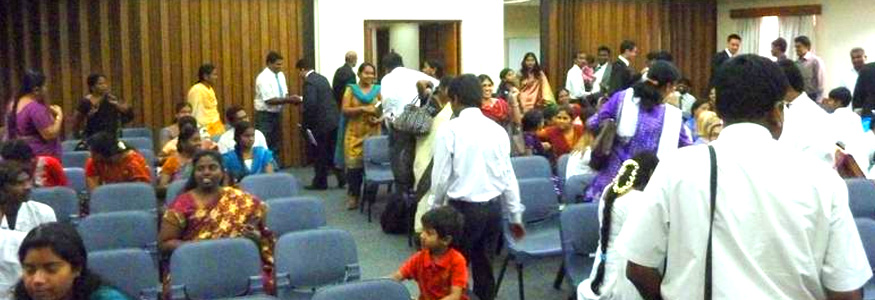Today’s Ride to Church comes to us from KC Kern, who recently did a Ride to the Book of Mormon Musical in Boston for us:
A few weeks ago I found myself in India as part of an academic field study project. I was staying in Hyderabad, the capital city of the southern Indian state of Andhra Pradesh. It is India’s 6th largest city, with a population of over 7 million. To my surprise, while getting a ride down one of the major highways in the city, I noticed a building with novel yet familiar architecture:

It was an LDS chapel, and only a few miles from my hotel. I later looked it up on maps.lds.org, and decided to check it out that Sunday. I got there a bit early, and was greeted by a hired security guard stationed at the gate. Looking inside the empty chapel, I noticed the ubiquitous Del Parson paintings and other universal staples of LDS chapel decor and accessories. I saw the Elders who were out by the side of the street waiting on an investigator to arrive.

People started arriving on foot, by communal taxi, and by motorcycle-often entire families on one motorcycle-and began to mingle in true LDS fashion. The men were dressed in typical Mormon-wear: white shirts, ties, suits. The women, however, all donned traditional saris with (gasp!) matching pants (churidars, technically).

Hyderabad has the only stake in India, due largely to a substantial availability of priesthood leaders in the area. The stake was organized less than a year ago. The local language is Telugu, but all the meetings were conducted in English, which is the language of business throughout India, even among Indians. Many of the women and older folks struggle with English though, so they revert into Telugu to express themselves. As sacrament meeting started, the bishopric sat on the stand of this newly minted ward, and one of the counselors conducted. The sacrament was blessed in English, and administered as one would expect. The first speaker was one of the first seven members to be baptized in India (about 30 years ago). The second speaker was an older woman who shared her testimony in Telugu. The Elders sang a hymn as a musical number, and a younger man was the concluding speaker. The hymns were sung either a cappella or accompanied by a right-hand-only melody, courtesy of a young woman on the electric piano.

Sunday school was taught by a woman who was baptized by my good friend Sam B. who (coincidentally) served as a missionary in that ward/branch around 3 years ago. She had married a recently returned missionary (India is in the Hong Kong temple district) and had a baby in tow. The lesson was about gathering Israel, which is a difficult enough concept as it is, but is even more confusing for those without the backdrop of Judeo-Christian heritage. The lesson was in English, but clarification, follow-up, and questions were often fielded in Telugu. Elder’s quorum was as usual. There were clipboards being passed around, fussing with the thermostat and fans, and class instruction based on a general conference talk. Some men were outspoken and opinionated, others were reserved and remained quiet. As meetings ended, the members filled the halls, catching up on stories and making plans for the week. Looking around elsewhere, I found the youth being instructed by their leaders, and a group of women tending the young kids in the nursery.

After being invited to an upcoming ward activity, I headed back to my hotel, struck by how simultaneously foreign and familiar the whole experience was. I wouldn’t be going back, but I still recognized these churchgoers in a distant land to be my people. And as I sat among them in the Mormon chapel folding chairs, I was one of theirs. [Link to Photos: http://imgur.com/a/R0uJ5/layout/grid]

thank you–
This is so cool, KC. I had no idea we had ward buildings like this in India.
Very interesting! Thanks for taking the time to share them with us!
I’ve been thinking a lot about Mother In Heaven recently. I wonder if that is something missionaries ever talk about in India-at least with the Hindu portion of the population. If they did, would they have more success simply because Hindus embrace the Divine Feminine.